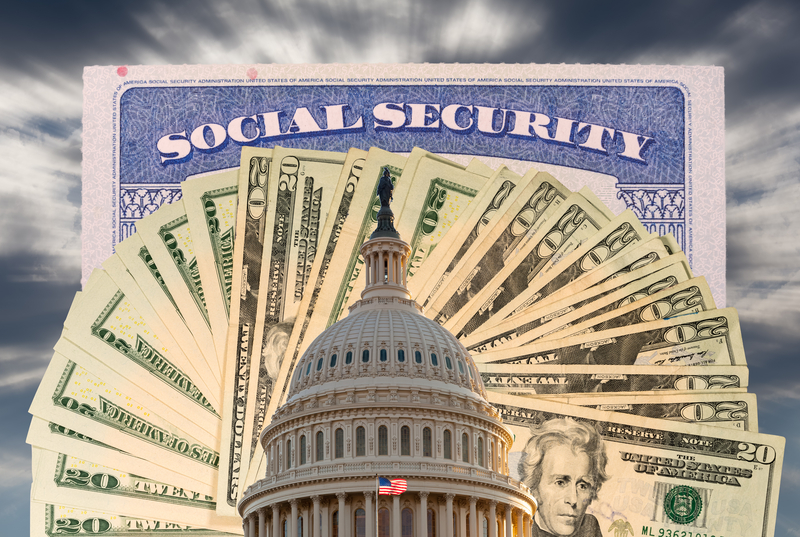Category: Personal Finance
Legal and Financial Planning for Those with Alzheimer’s and Their Caregivers
November 1, 2023

If you or a loved one is diagnosed with Alzheimer’s or dementia, then there are certain things that you will need to plan for legally and financially. An estimated 6 million Americans have Alzheimer’s, and it is currently the seventh leading cause of death in the United States. Alzheimer’s is a brain disorder that slowly decreases memory and thinking skills, while dementia involves a loss of cognitive functioning; both cause more and more difficulty for an individual to perform the most simple tasks. Though a diagnosis can be scary, the right planning can help individuals and their families feel more at ease.
Putting Legal Documentation in Place
Christopher Berry, Founder and Planner at The Elder Care Firm, recommends three main disability documents that should be in place.
First, there needs to be a financial power of attorney, a document that designates someone to make all financial decisions once an individual is unable to do so for themselves. If an individual lacks a trusted loved one to make financial decisions, then designating a financial attorney or bank is an option.
The next document that needs to be in place is the medical power of attorney that designates someone to make medical decisions for an individual. In many cases, it may be appropriate to appoint the same person to be the financial and medical power of attorney, as long as that person is well-trusted by the individual. In the event that something happens to the original power of attorney(s), successor (or back-up) agents for power of attorney(s) should also be designated.
The last document is the personal care plan, which instructs the financial and medical power of attorney(s) on how best to care for the individual in need. For instance, those entrusted to the care of an individual will need to make sure they sign medical records release forms at all doctor’s offices; copies of the power of attorney or living will should also be given to healthcare providers.
These three documents provide a foundation to make decisions for the individual diagnosed with Alzheimer’s or dementia when they no longer can themselves. It’s ideal to include the individual in these conversations in the early stages of their diagnosis, so that they may be a part of the decision-making process and appoint people that they will feel most comfortable with during their care.
How to Pay for Long-Term Care
Since Alzheimer’s is a progressive disease, the level of care an individual needs will increase over time. Care costs may include medical treatment, medical equipment, modifications to living areas, and full-time residential care services.
The first thing a family can do is to use their own personal funds for care expenses. It’s important for families to remember that they will also pay in their time, as many children of loved ones with Alzheimer’s or dementia will become the main caregivers. It may be wise to meet with a financial planner or sit down with other family members, such as your spouse and siblings, to determine how long some of you may be able to forgo work in order to provide full time care.
When personal funds get low or forgoing work for a period of time becomes difficult, long-term care insurance can be a lifesaver. The key to relying on long-term care insurance though is that it needs to be set up ahead of the Alzheimer’s or dementia diagnoses, so considering these plans as one ages may be smart.
Veterans can make use of the veterans benefit, or non-service-connected pension, which is sometimes called the aid and attendance benefit. This benefit can help pay for long-term care of both veterans and their spouses.
Finally, an individual aged 65 or older can receive Medicare, while those that qualify for Medicaid can receive assistance for the cost of a nursing home. If someone’s income is too high to receive Medicaid, then the spenddown is one strategy to know; under spenddown, an individual may subtract their non-covered medical expenses and cost sharing (including Medicare premiums and deductibles) from their available income. With the spenddown, a person’s income may be lowered enough for them to qualify for Medicaid.
Minimizing Risk Factors During Care
Research published recently in the journal Alzheimer’s & Dementia found that nearly half of patients with Alzheimer’s and dementia will experience a serious fall in their own home. Author Safiyyah Okoye, who was at John Hopkins University when the study was conducted, recommends minimizing risks such as these by safeguarding homes early on in diagnoses. “Examining the multiple factors, including environmental ones like a person’s home or neighborhood, is necessary to inform fall-risk screening, caregiver education and support, and prevention strategies for this high-risk population of older adults,” she states.
The good news is that since the progression of Alzheimer’s is often slow, families have plenty of time to modify the home for increased safety.
In addition to fall prevention modifications, other safety measures may include installing warning bells on doors to signal when they’re opened, putting down pressure-sensitive mats to alert when someone has moved, and using night lights throughout the home. Coats, wallets, and keys should also be kept out of sight, because at some point, leaving the home alone and driving will no longer be safe. Conversations about these safety measures, such as when an individual will have to stop driving, are ones that caregivers should have early on with their loved ones. Including individuals in their future planning while they are still cognitively sound will help both them and their caregivers feel more comfortable with the journey ahead.
It’s important to remember that even though receiving an Alzheimer’s or dementia diagnosis can be devastating, it is not the end. People with Alzheimer’s can thrive for many years before independent functioning becomes difficult. Both patients and caregivers will feel more calm through planning ahead. Insureyouknow.org can help caregivers stay organized by storing all of their important documents in one place, such as financial records, estate planning documentation, insurance policies, and detailed care plans. Above all, there is hope for those with Alzheimer’s; research is happening every day for potential therapies and future treatments.
Five Things To Know About the Capital Gains Tax
September 15, 2023

It’s never too early to start planning for tax season. While much of what you own will experience depreciation over time, any profit made from something you sell may be subject to the capital gains tax. So if you think you’ll be making a return on a previous investment this year, then you’re going to want to be well-versed in the capital gains tax.
Understanding the Capital Gains Tax
A capital gains tax is a tax on profits made from the sale of assets, such as stocks, businesses, real estate, and other types of investments. When you sell anything and make a profit, the U.S. government views that profit as taxable income. The capital gains tax is calculated by deducting the original cost of the asset from the total sale of that asset. It’s important to understand the capital gains tax guidelines, such as profits made from real estate or collectibles, which come with their own unique rules. Understanding the rules can help you make the best decisions about your capital gains income.
In order to minimize losses and maximize your gains, here are five things to know about the capital gains tax.
The Real Estate Rules
If a person sells their home for $250,000 or less, or a married couple sells their home for $500,000 or less, then they are exempt from the capital gains tax; this exemption is only available once every two years. If you sell your home or any other investment property for more than that but reinvest the money made from the sale into a new property, then you would also be exempt from paying taxes on your real estate gains; this is known as the 1031 exchange. Cory Robinson, financial portfolio manager says, “That’s the beauty of taking gains: You can immediately reinvest.” For a home to qualify as a primary residence, you must have lived in it for at least two years, or two years out of a five year period. It’s important to understand the rules around property sales, so speaking with an advisor is always recommended before selling your home. “Familiarize yourself with the capital gains tax exclusion rules and consult a tax advisor,” says financial analyst Greg McBride. “If the property has been your primary residence for less than 24 months, for example, you may decide to hold off until you’ve reached that threshold to avoid capital gains tax.”
The Difference Between Short and Long-term Capital Gains
Put simply, if you have held any asset for less than a year before selling it, then that asset is considered a short-term capital gain and is subject to a higher capital gains tax; if you own that asset for longer than a year before selling, then your profit is considered a long-term gain and subject to a lower tax rate. This is why selling any asset before you’ve owned it for at least 12 months should be avoided if possible.
Investment and Rental Property Strategies
The rules around investment property are different since their value typically depreciates over time. A 25 percent rate then applies to the gain from selling real estate that depreciated, because the IRS wants to recapture some of the tax breaks you’ve been getting due to depreciation, known as Section 1250 property. If you sell a rental property that you have not lived in for at least two years for over $250,000 (or $500,000 if married), then that property could be subject to not only the depreciation rate but a capital gains tax that is based on your income bracket. One wat to avoid this could be to invest in property in opportunity zones, areas identified as economically disadvantaged, which are tax-free when sold after ten years. Deducting expenses, such as home improvements, repair, and even closing costs, is another way to lower the amount of profit that is subject to the capital gains tax.
Your Income Bracket Determines Your Capital Gains Tax Rate
Tax rates are determined by your tax bracket, so a lot of people will actually pay no capital gains tax on the sale of long-term assets if they fall in the 0% tax rate. For the 2023 tax year, a single person that made up to $44,625, and a married couple that made up to $89,250 jointly would not have to pay any capital gains taxes.
Keep Track of Both Gains and Losses
When an asset is sold for more than what it cost, it results in a capital gain, but when the asset is sold for less than it cost, it results in a capital loss. If you have both gains and losses, it will be important to know your net gain, or your gains minus your losses; only net gains are subject to the capital gains tax. If you only have losses in a given year, then capital losses could actually lower your taxable income. This loss is limited to $3,000 per year per person (or $1,500 if you’re married). If you have an excess of $3,000 in losses, then those losses can actually be carried forward to future tax years.
It’s never a good idea to buy or sell assets solely for tax purposes, but that doesn’t mean you shouldn’t be well aware of the rules around the capital gains tax. Insureyouknow.org can help you store all of your financial records in one place, so that it’s easier for you to keep track of your assets and taxable income. Before selling any investment, it’s important to know the laws unique to your state and speak with an advisor, who will know best what taxes you may be held responsible for. It’s good to know that for many, zero taxes on gains are actually possible.
5 Benefits of Paying Off Your Mortgage Early
August 17, 2023

For many Americans, a home mortgage is one of the heftiest and lengthiest investments they will make in their lifetime. According to the Federal Reserve Bank of New York, mortgages accounted for 71% of combined household debts in 2022. The good news is with proper planning, this stressor can be eliminated. Depending on your financial position, opting to pay off your mortgage early can make a positive impact on your finances. It can simultaneously offer you a sense of peace and stability and provide greater financial freedom.
“Paying off your mortgage is a major milestone,” said Meaghen Hunt of Bankrate. “It’s a moment to celebrate, but also to take specific steps to ensure you’re the legal owner of the property, and to continue paying your homeowners insurance and property taxes on your own.”
- Reduce Interest Costs
The more time you carry a mortgage for, the more interest you will pay. Paying off your mortgage early allows you to save significantly on interest. Laura Tarpley of Business Insider estimates that paying off your mortgage early could save you tens of thousands of dollars. “Just make sure to clarify with your lender that all extra payments will just be going toward your principal, not interest,” she cautioned.
- Live Debt-Free
Forbes estimates that nearly 10 million American homeowners who are still paying off their mortgages are 65 years of age or older. That is a significant number of individuals still saddled with debt well into their old age. The increased financial security of having a paid-off mortgage means greater room in your finances to address other debts. The funds spent to make a mortgage payment can be redistributed to pay off other outstanding debts such as loans, credit card balances, and more. Overall, the ability to live debt-free without the stress of having to make a substantial payment is a significant benefit.
Hunt cautions that you may see your credit score suffer after paying off your mortgage especially if it was the only debt you carried. Although there is a brighter side. “In some cases, your score can improve, depending on what other kinds of credit you’ve borrowed,’ she added.
- Eliminate Monthly Payments
Most homeowners can expect to pay off their homes in 30 years making normal monthly payments. Not having to meet monthly payments frees up a sizable amount of money that can be invested in other, potentially high-earning, endeavors. This could allow for more wealth to be generated over time. Additionally, if you are unable to make your monthly payments due to financial instability, you are protected from losing your home.
- Be Financially Free
Mortgage payments often make up a substantial portion of one’s expenses and are also multi-year, with the average mortgage spanning between 15-30 years. Paying off your mortgage ahead of schedule frees up funds and allows for greater room to direct funds to other places.
“For people nearing retirement, a paid-off mortgage means they have that much more free cash flow from their fixed income when they stop working,” said Miranda Marquit of Bankrate. “It allows you to tap the equity in your home if you need money in the future.”
- Have Peace of Mind
Arguably one of the most advantageous benefits of having a fully paid mortgage is the right to own your home outright. Additionally, it protects you from the instability of the housing market which can lower the value of your home.
Insureyouknow.org
Having a mortgage paid off early provides many advantages, such as money saved long-term that permits debt and interest-free living and greater availability of funds to direct towards other investments. While not having to keep up with costly monthly payments into your retirement sounds appealing, it is important to take inventory of your finances before making the decision to pay off your mortgage early. Use insureyouknow.org to keep a track of your payments and debts to determine if an early mortgage payment is the right fit for you.
Scammer on the Rise: How to Protect Yourself in Retirement
June 1, 2023

A change in your retirement savings balance could be the result of recent stock market volatility, or because your account has been accessed by someone else and compromised. The National Association of Plan Advisors reported that hackers have been targeting retirement accounts, either through large-scale attacks on financial institutions or by using stolen personal information. Bryce Austin with TCE Strategy said that a hacker can get into your 401(k) two ways, either by “retrieving your credentials with the financial institution” and pretending to be you or by convincing you to do it “on their behalf.” Scammers have been known to contact people posing as the police, claiming that their funds are at risk and convincing them to transfer their retirement money into a “safer” account. If someone does so, then there’s no legal recourse, because they are doing so deliberately; the savings are “just gone,” Austin said. It’s important that retirees are aware of this trend and make sure that their accounts are secure.
Set Up Online Access to Your Accounts
First, make sure that you have online access to all of your retirement accounts. This will allow you to monitor your own accounts regularly. If you ever notice any unusual activity or changes that you have not made yourself, contact the institution immediately. Some firms will not reimburse account holders for fraudulent transactions if they aren’t reported during a certain time frame. Establishing online access also prevents someone else from doing so before you can, since thieves have been known to use stolen information to access and retrieve funds. Create your own Social Security account at ssa.gov while you’re at it, so that hackers don’t divert your Social Security benefits to their own accounts. When out and about, do not use public WiFi connections to check your accounts. Unfortunately, hackers can access these networks and steal your personal information by viewing your online activity.
Access your Accounts Safely
Once you have access to your accounts online, make sure you use a strong password and change it regularly. Your password should be something that a hacker cannot easily guess, such as your or a loved one’s birthday. Next, use multi-factor authentication if your institutions offer this step. Requiring multiple verifications to access your account can stop thieves in their tracks, as well as alert you if someone else is trying to access your account. If you are able to, financial author Cameron Huddleston suggests naming a trusted contact. A trusted contact cannot access your account, but your institution can contact them and make sure that it is actually you who is trying to access your funds.
Periodically Check Your Credit Reports
In addition to monitoring your own accounts, checking your credit reports regularly is one more easy thing you can do to catch any unusual activity on your accounts. A credit report shows all accounts that you have opened, balances, and can even find data breaches. A data breach can compromise your personal information and alert you to change your passwords or close a compromised account. A sudden fluctuation in your credit score can also be a sign that something isn’t right.
How to Recognize (and Avoid) a Scam
If you receive a suspicious phone call, text message, email, social media message, or letter that doesn’t seem right, then trust your gut. The caller or sender may not be who they say they are and it’s likely a scam. If you want to be sure, then you can call the company’s customer service line and verify that they meant to contact you. No matter how official the message may seem, that doesn’t mean it’s authentic. Many scammers pretend to be from the Social Security Administration, Medicare, IRS, or credit card companies. Lawyer and author Steve Weisman says, “The IRS and the SSA will never initiate contact with people through a phone call, so you can be sure that the person calling you is a scammer.” The same goes for Medicare. Your Medicare number is valuable and can enable a criminal to steal health benefits, so if anyone is asking you for your Medicare number, then this is a sure red flag that they are a scammer.
Perhaps the number one rule for protecting yourself against a scam is to never provide anyone with personal information without verifying their true identity. Again, this can be done by hanging up or ignoring the message and calling the company directly. Also, be mindful of your mail. Any documents with sensitive information should be shredded, and if anyone else is retrieving your mail, make sure they are someone you trust. Opting for paperless statements is another safeguard against anyone stealing personal information via your mail.
Anyone who is trying to rush you into making an important financial decision likely does not have your best interests at heart. It’s important to research any company that you plan to invest with. Before buying stocks, you can even check the SEC’s EDGAR database. Be especially skeptical of anyone who is pitching something in a time-sensitive manner, such as a “once in a lifetime opportunity.” A true financial advisor will respect your desire to think it over and even encourage you to do so. Before making any important financial decisions, it’s not a bad idea to refer to a trusted professional anyway. That being said, anyone telling you to “leave everything to me” may not deserve that much of your trust. At the end of the day, you should always be your own expert on your retirement and finances.
The best defense against retirement theft is your willingness to take a few extra steps to protect your accounts, such as using multi-factor authentication and monitoring your own accounts on a regular basis. Most of all, remain diligent about who you’re providing sensitive personal information to. These are simple ways to protect your nest egg and gain valuable peace of mind. Insureyouknow.org can help you store all of your financial information in one place so that your retirement accounts and other finances are easy to monitor. Then you can get back to worrying about what’s really important, such as how you’ll be enjoying your retirement.
Do You Realize How “Precious” a Child Is?
September 15, 2022

The cost of raising a child through high school has risen to $310,605 because of inflation that is running close to a four-decade high, according to an estimate by the Brookings Institution, a nonprofit public policy organization based in Washington, DC.
In 2017—years before the pandemic and during an extended period of very low inflation—the U.S. Department of Agriculture (USDA) projected that the average total expenditures spent on a child from birth through age 17 would be $284,594. This estimate assumed an average inflation rate of 2.2 percent and did not include the expenses associated with sending a child to college or supporting them during their transition to adulthood. Since 2020, the inflation rate has skyrocketed— 8.5 percent as of July 2022—partly due to supply-chain issues and stimulus spending packages that put more cash into Americans’ pockets. The Federal Reserve has now raised interest rates substantially to control inflation.
The multiyear total is up $26,011, or more than 9 percent, from a calculation based on the inflation rate two years ago, before rapid price increases hit the economy, reports the Brookings Institution.
The new estimate crunches numbers for middle-income, married parents, and doesn’t include projections for single-parent households, or consider how race factors into cost challenges.
Expenses
The estimate covers a range of expenses, including housing, education, food, clothing, healthcare, and childcare, and accounts for childhood milestones and activities—baby essentials, haircuts, sports equipment, extracurricular activities, and car insurance starting in the teen years, among other costs.
In 2019, the typical expenses to raise a child were estimated by the USDA as follows:
- Housing: 29%
- Food: 18%
- Childcare and Education: 16%
- Transportation: 15%
- Healthcare: 9%
- Miscellaneous (included Personal Care and Entertainment): 7%
- Clothing: 6%
Housing
Housing at 29 percent is the most significant expense associated with raising a child. The cost and type of housing vary widely by location. Other variables include mortgage or rent payments, property tax, home repairs and maintenance, insurance, utilities, and other miscellaneous housing costs.
Food
The cost of food is the second-largest expense, at 18 percent of the overall cost of raising a child. Over time, food prices have trended up, with food-at-home pricing increasing 12.1 percent and food-away-from-home pricing increasing by 7.7 percent from June 2021 to July 2022. The USDA expects rising costs for 2022, with increases as high as 10 percent and 7.5 percent, respectively.
Childcare and Education
Childcare and education expenses in 2019 accounted for 16 percent of the cost of raising a child, and it continues to increase.
The widespread acceptance by employers of remote work and letting employees work from home part or full-time has eased the burden of childcare costs for many families, cutting the cost by as much as 30 percent for some workers.
Education is a major expense when it comes to raising children. When it comes to kindergarten through high school, parents can choose between public and private schools. For private schools, the Education Data Initiative estimated that tuition costs an average of $12,350 per year. Associated costs, like technology, textbooks, and back-to-school supplies, could bring that up to $16,050. For a child to be in private school from kindergarten through eighth grade, the estimated cost could be about $208,650. Additional expenses for extracurricular activities such as sports, the arts—music, theater, and yearbook—and other clubs also add up and are accompanied by fees for participation, equipment, and travel, which have also increased due to inflation.
Healthcare
The total cost of a health plan is set according to the number of people covered by it, as well as each person’s age and possibly their tobacco use. For example, a family of three, with two adults and a child, would pay a much higher monthly health insurance premium than an individual.
Strategies
Raising children is rewarding and fulfilling to many people. But it’s also become very expensive. By preparing mentally and implementing financial planning strategies, you can be well-equipped to raise your child to adulthood comfortably, even on a budget.
InsureYouKnow.org
If you are a parent, you are responsible for raising your child and providing food, clothing, shelter, and security. Consider getting insurance coverage—including life, short- and long-term disability, and health insurance to avoid putting your family at risk financially in the event of unexpected hardship. To cope with the rising costs of raising children, live within your means, save money wherever possible, and shop around for home and auto insurance each year for the best deals. At insureyouknow.org, you can track your expenses to raise a child and file insurance policies that cover your family’s financial and healthcare needs.
Ask or Be Asked: Executor of an Estate
March 2, 2022

An executor of an estate is someone called upon to settle a deceased individual’s financial affairs. In your will, you may name a close relative, friend, accountant, attorney, or financial institution to act as executor of your estate. You also may designate co-executors—more than one person to handle your affairs. If you are asked to be an executor, consider it a great honor. But at the same time, keep in mind that it is also a great responsibility.
You should select an executor with integrity and good judgment. The law requires an executor to act in the estate’s best interest—known as “fiduciary duty”—even if they are also an heir, which is often the case. You’ll need to make sure they understand and are prepared for the job.
The Duties of an Executor of an Estate
An executor’s responsibilities can vary depending on the complexity of your estate, and the decisions you designate in your will. Following are some of the duties an executor of an estate performs.
- Locate the last will and file it in probate court
- Obtain certified copies of the death certificate
- Notify the state department of health of the death if a funeral home, crematorium, hospital, or nursing facility has not
- Distribute assets to beneficiaries
- Pay creditors
- Issue notices of death to banks, government agencies, and insurance companies
- File final tax returns
- Maintain property until the estate is settled
- Arrange care for any pets
- Make court appearances on behalf of the estate
- Notify current employer, if applicable
- Notify the deceased’s beneficiaries of the probate hearing
- Keep accurate records
- File the final accounting with the court and close the estate
As an executor, you may discover you need to hire a professional such as an accountant or attorney to help value and distribute certain assets, including:
- Assets with disputed ownership
- Business interests
- Royalties
- Out-of-state assets
- Complex investments
Ambiguities in a will and substantial bequests to a minor also may require a professional’s expertise, which your estate will pay customarily.
The Decision to Serve as an Executor
If you are asked to serve as an estate’s executor, realize that it is a great honor and a great responsibility. Consider your decision carefully before you agree. Think about the time commitment as well as the skillset and temperament required to perform the duties. Find out why the person asked you to serve as an executor and discuss his expectations for you to fill this role.
With this disclosure, you should be able to decide if you are qualified for the job and your fulfillment of an executor’s duties will be appreciated.
Compensation Considerations
Many executors perform their duties without compensation, especially if they are one of your estate’s beneficiaries. But executors can get paid for their work, and this arrangement is more common if the executor is a person outside your family or if settling your estate requires significant expenses such as travel, filing court documents, or overseeing the sale of your real estate.
Another option for you is to limit in your will the fees to a specific dollar amount. Or you may specify the payment of reasonable fees based upon state law.
Typically, executors can expect to get paid once the estate is settled. If they incur out-of-pocket expenses, such as utilities, property taxes, insurance, and storage fees before the estate is settled, they can usually reimburse themselves during their estate administration. But again, compensation is a subject that should be spelled out before you accept an executorship. Spending down any estate monies can be an area of great sensitivity, especially if heirs believe their inheritance was reduced because of your executorship.
InsureYouKnow.org
When you select an executor of your estate who accepts the responsibility to carry out your wishes regarding your estate upon your death, ask yourself the following five essential questions. Let the executor know if the answers can be found on your InsureYouKnow.org portal.
- Where is your original will? If you keep your will in your house, be specific about where to find it. If you filed it with your attorney, provide contact information. Don’t store it in a safe deposit box, where it may be difficult to access after your death. You should share your InsureYouKnow.org access credentials with the executor of your estate to be able to find a copy of your will online.
- Who should be notified? Compose a list of people and organizations with contact information for your executor to contact. If you keep this list at InsureYouKnow.org, you can update it regularly.
- What are your passwords and access codes? Let your executor know how to retrieve your passwords and access codes for email, social media, other media accounts, cellphones, and computers. Store and keep this data current at InsureYouKnow.org.
- Who will receive your possessions? If you have nonfinancial items such as family recipes, photos, heirlooms, and memorabilia, keep details with designated recipients at InsureYouKnow.org.
- Do you have any secret items? Let the executor or another person you trust know if you possess personal items that need to be dealt with on a confidential basis. Such items may include correspondence, photos, or documents personal in nature. You can keep a secure list of these items at InsureYouKnow.org.
Selecting a trusted executor to carry out your will is an important part of estate planning. Experts recommend updating your will every few years to make sure it still reflects your chosen executor and decisions to be carried out after your death. If you need to create or update your will, you can file copies at InsureYouKnow.org.
Whether you are the person asking or are the person being asked to be an executor of an estate, carefully consider and execute the responsibilities and duties required.
The Great Resignation Continues in 2022
January 29, 2022

“The Great Resignation” is a term coined in May 2021 by Anthony Klotz, Ph.D., an associate professor of management at Mays Business School at Texas A&M University who predicted the mass exodus of employees abandoning jobs during the pandemic.
In April, a month before Dr. Klotz made this prediction, a record 4 million people quit their jobs, many of them in low-paying, inflexible industries such as retail trade sectors and food services. He explained that during the pandemic, employees have been able to reflect about family time, remote work, commuting, passion projects, life and death, and what it all means which led workers to consider alternatives to their current positions.
Because the latest data suggests this trend, also called the “Big Quit,” will continue through 2022, employees, as well as employers, must prepare for changes in the workforce.
Employees
Before you submit your resignation, consider the following suggestions to guide your decision:
- Reassess your duties: Expanding your responsibilities within the company may offer the growth that you’re looking for without leaving your workplace. Promotion within your company may lead to a higher salary and additional benefits. On the other hand, you may feel overworked or are experiencing burnout, resulting in work-related stress, and seeking a less demanding opportunity may be a solution during this difficult time.
- Meet with your employer: If you prefer to work remotely, meet with your employer and plead your case to work all or part of your workweek away from the corporate office, especially if you have health and safety concerns, childcare issues, or COVID-related care responsibilities. Explain how important work/life flexibility is to you and ask if your employer is willing to consider your needs for your home life situation. Take this opportunity to ask if your salary, benefits, and health insurance could be improved to entice you to stay.
- Be flexible with your transition: If possible, notify your supervisor in person when you decide to resign and be flexible about the ending date in your position. Be professional in your exit interview, request a letter of recommendation for your files, find out when you’ll receive your last paycheck, and ask about the continuation of your benefits.
- Assess your financial situation: If you determine that you need to continue receiving a steady paycheck and insurance benefits, secure another position or outline a solid self-employment opportunity before you resign. If you are close to retirement age, figure out if you can delay collecting Social Security and retirement benefits so you can collect higher monthly payments in the future.
Employers
Employers who want to reduce staff turnover and retain experienced employers may benefit from the following tips adapted from the article, “How Employers Can Overcome The Great Resignation” from the Worth Media website.
- Be creative in putting together benefits packages that can support a diverse workforce with broad, varying needs.
- Remain flexible when employees choose their work locations.
- Keep an open line of communication with your employees.
- Emphasize the importance of employees’ mental and physical well-being.
- Prioritize pay equity and adopt a spirit of transparency.
- Remind your employees about your company’s mission, values, and vision.
- Treat employees who do leave with respect, a sense of professionalism, and kindness.
Employers’ main goal during this tumultuous time should be to remain calm, listen to employee feedback, and use it to make any necessary changes to their business model, benefits package, and salaries.
InsureYouKnow.org
Are you planning to join “The Great Resignation” in 2022? If so, consider not only how you can improve your present work situation but also what the future may hold for your career choices, continuing education, home life, insurance coverage, and financial goals. As you put each of these options in place, keep records regarding your decisions at insureyouknow.org.
The Most Wonderful/Stressful Time of the Year
December 1, 2021

Welcome to what is referred to as both the “most wonderful” and the “most stressful time of the year.” During the second year of the COVID-19 pandemic, you may be experiencing stress and depression—unwanted emotions that can ruin your holidays and impact your physical and mental health.
Although you can’t control inflation, high gas prices, food and toy shortages, and shipping delays, you can be realistic, plan ahead, and seek support to overcome holiday stress and depression. You may even end up embracing the “most wonderful time of the year.”
Tips to Deal with Seasonal Pressures
Be realistic. COVID-19 cases are on the rise in some areas and even if you’ve been vaccinated, you may decide not to gather with friends and relatives in person. You can opt for a virtual celebration or increase efforts to share photos, texts, emails, phone calls, or videos with loved ones.
Avoid overspending, especially if you’re already feeling financial stress. Consider alternatives to expensive gifts by donating to charities in giftees’ names or by making and giving homemade presents.
Strive to decorate your home, create meals and desserts, and select gifts that will be appreciated not because they are “perfect” but because they are heartfelt and sincere.
Plan ahead. Compile lists of recipients and specific gift ideas; don’t go to browse in busy stores, hoping for inspiration. Save time and frustration caused by traffic and parking congestion by shopping online for items on your gift list. Schedule specific times to shop, bake, and attend social events. Plan menus and then create a detailed grocery list to prevent forgetting needed ingredients.
Acknowledge your feelings. Stress about gatherings with family and friends, or feeling grief about missing loved ones, may result in sadness and grief. Take time to acknowledge and express your feelings. You can’t force yourself to be happy just because it’s the holiday season. If you celebrate in person or in other ways as described above, set aside differences and controversial topics and concentrate on positive conversations.
Practice mindfulness by bringing your attention to the present moment and avoid getting stressed about past or future events.
Reach out. If you feel lonely or isolated, seek out community, religious or other social events, or communities. Many helpful organizations have websites, online support groups, social media sites, or virtual events that can offer support and companionship.
Volunteering your time and doing something to help others also are good ways to lift your spirits and broaden your friendships. Consider dropping off a meal and dessert at a friend’s home or to a community center that serves less fortunate individuals during the holidays.
Learn to say no. Set priorities based on preserving your well-being and don’t overextend yourself or you may wind up feeling resentful and overwhelmed. Learn to feel guilt-free when you decline invitations and recognize that you sometimes need to allow yourself to say no to demands on your time.
Maintain healthy habits. Get ample sleep, eat well—even at holiday events—and stay physically active in your daily routine. Maintaining healthy habits during the holiday season will be one of your best defenses against stress. When you feel a bout of stress coming on, have a healthy snack before a holiday party to curb your desire for high-calorie food and drink. Try deep-breathing exercises, meditation, or yoga. Avoid excessive tobacco, alcohol, and drug use.
Take a breather. Make time for yourself. Find an activity you enjoy like taking a walk, listening to calming music, or reading (or listening to) a book. Disconnect temporarily from social media and electronic devices.
Seek professional help if you need it. Even after following all the tips listed above, you may find yourself feeling continuously sad or anxious, beset by physical complaints and lack of sleep, and unable to face daily chores. If these feelings last for a while, talk to your doctor or a mental health professional. If you rely on medications to maintain your physical and mental health, make sure your prescriptions are up-to-date and that you have an adequate supply when your doctor’s office or pharmacy may be closed or have reduced hours during the holidays.
InsureYouKnow.org
At InsureYouKnow.org, you can keep a handy record of your prescriptions, refill expiration dates, and contact information for healthcare providers who prescribe and pharmacies that fill your medications.
Saving with a 529 College Plan
August 30, 2021

As college students return to campuses this fall, they (and in many cases, their parents) face costs that have tripled in 20 years, with an annual growth rate of 6.8 percent.
Melanie Hanson at educationdata.org reports that the average cost of college (considered to be any postsecondary educational institution that offers an undergraduate degree program) in the United States is $35,720 per student per year. Current college cost data also reveal:
- The average in-state student attending a public 4-year institution spends $25,615 for one academic year.
- The average cost of in-state tuition alone is $9,580; out-of-state tuition averages $27,437.
- The average traditional private university student spends a total of $53,949 per academic year, $37,200 of it on tuition and fees.
- Considering student loan interest and loss of income, the ultimate cost of a bachelor’s degree may exceed $400,000.
In the academic world, the cost of college is generally referred to as the cost of attendance (COA). Each college has its own COA consisting of five items:
- Tuition and fees
- Books and supplies
- Room and board
- Transportation
- Personal expenses
Twice per year, the federal government recalculates the COA for each college and then adjusts the figures for inflation to determine students’ financial needs when they apply for financial aid.
Planning in Advance
Advance planning for education costs is advisable to keep ahead of college inflation.
Regular investments add up over time. By investing even a small amount of money on a regular basis in a college fund, you have the potential to accumulate a significant amount if you start when your child (or grandchild) is young.
Once you have a sense of your college savings needs, make sure you are investing the money appropriately. Among several available college savings options described by Fidelity, a great place to start is to open and contribute to a 529 college savings plan account. It’s popular with parents and grandparents because there are few restrictions and the benefits are plentiful. You can potentially reduce your taxes and retain control over how and when you spend the money.
Education savings plans were first created in 1986, when the Michigan Education Trust established a prepaid tuition plan. More than a decade later, Section 529 was added to the Internal Revenue Code, authorizing tax-free status for qualified 529 tuition programs. Today there are more than 100 different 529 plans available to suit a variety of education savings needs.
To make sure you are on track with your savings goals, and to ensure you have an appropriate investment mix, revisit your plan at least annually. Over time, you will likely need to update the costs of schools you are considering, your financial aid situation, your child’s school preferences, school location, and your investment performance. When you’re ready to start paying for school, withdrawals are federal income tax-free when used for qualified education expenses.
Setting Up and Using a 529 Savings Account
- The requirements to open a 529 savings account are simple. You must be a U.S. resident, at least 18-years old, and have a Social Security or tax ID number.
- 529 plan savings can cover a range of educational expenses, in addition to college tuition. You can use up to $10,000 from a 529 account each year per beneficiary on elementary, middle, or high school tuition. At the post-secondary level, money saved in a 529 plan account can be used for a variety of higher-education-related expenses: tuition and fees, room and board, books and supplies, and computers and related equipment.
- Money saved in a 529 plan may have only a small impact on financial aid eligibility.
- You don’t have to be related to the beneficiary on the account to open a 529 account for them. Friends or family members can open a 529 college savings account regardless of their income or relationship to the student—and can even name themselves as the student beneficiary on the account. Anyone can contribute and you can encourage donations to a college savings account as a birthday or holiday gift.
Reaping Tax Benefits
A 529 savings plan works much like a Roth 401(k) or Roth IRA by investing your after-tax contributions in mutual funds, ETFs (exchange-traded funds), and other similar investments. Your investment grows on a tax-deferred basis and can be withdrawn tax-free if the money is used to pay for qualified higher education expenses. Contributions are not deductible from federal income taxes.
You may also qualify for a state tax benefit, depending on where you live. More than 30 states offer state income tax deductions and state tax credits for 529 plan contributions.
Choosing a 529 Plan
Nearly every state has at least one 529 plan available, but you’re not limited to using your home state’s plan. Each 529 plan offers investment portfolios tailored to the account owner’s risk tolerance and time horizon. Your account may go up or down in value based on the performance of the investment option you select. It’s important to consider your investment objectives and compare your options before you invest.
Withdrawing from a 529 Plan
You can use your education savings to pay for college costs at any eligible institution, including more than 6,000 U.S. colleges and universities and more than 400 international schools.
Once you’re ready to start taking withdrawals from a 529 plan, most plans allow you to distribute the payments directly to the account holder, the beneficiary, or the school. Read “How to Pay Your Tuition Bill With a 529 Plan” to learn more.
Remember, you will need to check with your own plan to learn more about how to take distributions. Depending on your circumstances, you may need to report contributions to or withdrawals from your 529 plan on your annual tax returns.
Dealing with Leftover Funds
If your child doesn’t go to college or gets a scholarship, you won’t lose the college fund you have accumulated. Generally, you will pay income tax and a penalty on the earnings portion of a non-qualified withdrawal, but there are some exceptions. The penalty is waived if:
- The beneficiary receives a tax-free scholarship
- The beneficiary attends a U.S. Military Academy
- The beneficiary dies or becomes disabled
The earnings portion of the withdrawal will be subject to federal income tax, and sometimes state income tax.
If you have leftover money in your 529 plan and you want to avoid paying taxes and a penalty on your earnings, you have a few options, including:
- Change the beneficiary to another qualifying family member
- Hold the funds in the account in case the beneficiary wants to attend school later
- Make yourself the beneficiary and further your own education
- Roll over the funds to a 529 ABLE account, a savings account specifically for people living with disabilities
- Since January 1, 2018, parents also have the option to take up to $10,000 in tax-free 529 withdrawals for K-12 tuition
- Since January 1, 2019, qualified distributions from a 529 plan can repay up to $10,000 in student loans per borrower for both the beneficiary and the beneficiary’s siblings
You can withdraw leftover money in a 529 plan for any reason. However, the earnings portion of a non-qualified withdrawal will be subject to taxes and a penalty, unless you qualify for one of the exceptions listed above. If you are contemplating a non-qualified distribution, be aware of the rules and possible tactics for reducing taxes owed.
InsureYouKnow.org
If you’re interested in setting up a 529 college savings plan, do your homework on the benefits, qualified uses for account balances, and the low impact on financial aid. File your findings and, once you start receiving account statements, keep track of your college saving account as it prospers.
Retirees Face the Rising Cost of Living
August 14, 2021

Have you noticed this year that your grocery bill has been rising and the price of gas is higher each time you fill up at the pump? You also may have been shocked by sticker prices on new and used cars and trucks resulting from inflation in recent months.
Consumer Price Index
On July 11, 2021, the Labor Department reported its consumer price index (CPI) rose 5.4 percent in July from a year earlier, in line with June’s figure and matching the largest jump since August 2008. White House officials are cautiously optimistic that the current increase in prices will be transitory, citing a continued drop in forward prices for lumber and other goods that experienced sharp increases because of supply chain bottlenecks. Steel capacity also had risen substantially over the past few months, they said.
The Federal Reserve has been keeping a close eye on inflation reports since it’s the central bank’s job to maximize employment and keep prices stable. Chairman Jerome Powell and other officials acknowledge the recent acceleration in prices but believe that the inflation is “transitory” and that prices won’t continue to increase at their current pace for too long.
As one of the most-cited inflation gauges, the CPI measures changes in how much American consumers pay for everyday goods and services including groceries, gasoline, clothes, restaurant meals, haircuts, concerts, and automobiles.
The CPI and other price measures have been on the rise in 2021 in large part because of a comeback in consumer spending and U.S. gross domestic product (GDP) as COVID restrictions eased.
Economic activity as measured by GDP rose at an annualized rate of 6.5 percent in the second quarter as Americans frequented restaurants, took summer vacations, and resumed other activities that COVID-19 had hindered.
Consumer Spending
Consumer spending, bolstered by the nationwide rollout of vaccines, jumped 11.8 percent during the three months ending June 30, the second-fastest rate since 1952.
At the same time, the pent-up demand for travel, retail, and restaurants has left many businesses scrambling to keep up and led to several setbacks on the supply side of the U.S. economy.
Employers who have struggled to find workers have hiked pay or offered signing bonuses to help fill the record 10.1 million job openings across the economy at the end of June. The leisure and hospitality sector, which includes restaurants, bars, and hotels, has one of the highest levels of job openings at more than 1.6 million.
But instead of absorbing higher labor and material costs, some businesses have begun to pass on the impact of higher wages to their consumers.
Inflation and Retirees
Higher prices take a significant toll on retirees. Social Security benefits rise only once a year. “Those with modest Social Security benefits are the ones who really have trouble,” reports Mary Johnson, Social Security and Medicare policy analyst at The Senior Citizens League, a non-partisan advocacy group. “Other retirees have had to tap more of their savings than they had planned because the Social Security benefit didn’t keep up with 2021’s hot inflation,” she says.
Inflation could prompt largest Social Security cost-of-living adjustment in decades. Retirees could see a 6.1 percent bump to their Social Security benefits in 2022. That would be the biggest increase since 1983, according to The Senior Citizens League, which calculated the figure.
The Social Security Administration typically announces the amount of the annual cost of living adjustment (COLA), if any, in October. The increase in benefits typically goes into effect in January.
You might not see all the increase in your benefit payment. If your Medicare Part B premiums are deducted from your Social Security (as is the case with 70 percent of Part B enrollees), a Medicare rate increase could offset all or part of the COLA.
The Social Security COLA for 2021 was 1.3 percent. For many retirees, that meant just $20 more per month. Over the years, the increases have led to a loss of buying power for seniors, according to research from The Senior Citizens League.
The amount your Social Security check will increase will be based on a combination of your underlying benefit and the Social Security COLA. Assuming the Social Security COLA is at the 6.1 percent level for 2022, and you are receiving the maximum Social Security benefit of $3,895, you would get an additional $237.60 per month. This would mean an increase of $2,851.14 per year.
The jump in benefits will be a bit more modest for those receiving the average Social Security benefit in 2021. Social Security benefits averaged just $1,543 per month in 2021. Again, assuming a 6.1 percent Social Security COLA, you could see your retirement benefits increase by $94.12 per month. When living on a fixed income, an additional $1,129.48 can go a long way.
If you are still working, make sure you have other retirement income to help maintain your standard of living. Even at the maximum Social Security benefit, you will have a tough time keeping your standard of living on Social Security alone. Work with a trusted financial planner to help determine the optimal time to claim your Social Security benefits and to set up a monthly payment schedule.
Currently, 69 million Americans are collecting Social Security benefits. So, a significant increase in the COLA to Social Security will be significant for the budgets of many retirees. Before the announcement is made in October, the Today show offers hints to help you save money at the grocery store, including keeping track of your grocery spending, taking inventory of what you already have and using it, and meal planning to reduce food waste and save on your food bill.
Smart shoppers will also watch for sales, comparison shop, and consider buying useful, non-perishable items in bulk and even making use of an extra freezer whenever possible. When it comes to saving money, cheap and healthy can go hand in hand.
InsureYouKnow.org
If you currently collect Social Security benefits or plan to in 2022, you can track at insureyouknow.org your monthly spending patterns, file copies of your Social Security and Medicare statements, as well as savings accounts you may have set up for vacations, rainy days, or emergency contingency plans.
